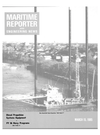
Page 25: of Maritime Reporter Magazine (March 15, 1985)
Read this page in Pdf, Flash or Html5 edition of March 15, 1985 Maritime Reporter Magazine
JOHNSON RUBBER
The water-lubricated bearings manufactured by the Duramax Ma- rine Division of The Johnson Rub- ber Company, Middlefield, Ohio, are furnished in sleeve and flanged types with naval brass shell in a full range of sizes. Sleeve bearings are also supplied with a non-metallic shell and are ideal where corrosion or electrolysis is a problem. Flanged bearings are available in solid or split style, and can be furnished for mate mounting with Duramax bronze stuffing boxes that are avail- able in shaft diameters up to 15 inches, and in models for air/water/ grease service, air/grease, air/water, water only, and grease service only.
Split styles are also available to facilitate installation and servicing in close quarters.
Stuffing boxes employing air ser- vice feature the Duramax rubber "Air Seal" ring, which when inflated seals itself around the propeller shaft and seals out water while packing is being changed. Deflating allows the rubber ring to retract to its normal position from around the shaft.
Duramax keel coolers for engine or auxiliary equipment cooling fea- ture spiral tubes of 90/10 cupro- nickel. Single—and double-bank models, which do not require through-the-hull fittings, range from four-tube to 24-tube.
Circle 77 on Reader Service Card
KAMEWA for a 98 V2 -foot catamaran ferry in 1980. The high performance of the units was verified by comprehensive full-scale measurements. The tests showed that the water jet propul- sion gave a fuel consumption equal to or lower than that expected for a fixed-pitch propeller installation.
Today KaMeWa water jet units have been ordered for commercial passenger ferries, passenger cruising craft, motor yachts, patrol boats, crewboats, workboats, and river towboats. Delivered units are in the power range of 161 to 13,410 bhp.
The commercially operated passen- ger ferry with the first delivery has accumulated more than 9,000 run- ning hours, during which a high degree of reliability of the 1,560-hp water jet units has been demon- strated. In total, all units in service have accumulated about 100,000 running hours.
Circle 78 on Reader Service Card
KHD
Klockner-Humboldt-Deutz AG (KHD) of Cologne, West Germany, recently introduced two centralized service systems for owners of Deutz marine diesel engines. Called Ship
Information Service (SIS) and
Ships' Information Processing Sys- tem (SIPS), they are designed as a new method for lowering engine (continued on page 28)
In 1937, KaMeWa of Sweden de- livered its first controllable-pitch propeller; since then, the company has been involved in marine propul- sion and is today the world's leading
CCP manufacturer. KaMeWa pro- pellers are produced in the U.S. by
Bird-Johnson Company of Walpole,
Mass.
In the mid-60s, the first KaMeWa water jet unit was delivered to the
Swedish Navy. This 250-hp unit was followed by a 480-hp installation in a private craft. Many potential water jet projects for all kinds of craft were investigated. It soon be- came clear that water jet propulsion provides some very positive charac- teristics, such as shallow draft and good maneuverability, but unfortu- nately combine with poor efficien- cy-
Thus water jet propulsion, with the then state of the art, could only be justified on some small, special- purpose craft, and the market was not very interesting for KaMeWa.
However, it was also realized that if the performance of water jet pro- pulsion could be improved to about the same level as that of a fixed- pitch propeller, water jet units could be a very interesting product. Thus a development program with this aim was started by KaMeWa, main- ly based on the model testing facili- ties already existing within the com- pany.
The first of these high-perform- ance, water jet units was delivered Circle 350 on Reader Service Card
The Cummins Advantage: More ton miles per gallon, ^ less repair costs per hour
The Cummins KTA's were selected by owner Lea Brent, based on customer reports compiled by Superior Boat
Works, a wholly-owned sub- sidiary of Brent Towing, which documented the K engine's sub- stantial fuel savings advantage over other diesels of similar size.
According to tea Brent, "All in all the KTA-2300's have met our ex- pectations and then some. They have required very little mainte- nance, and when you do need service, Cummins is right there."
When compared with her two sisterships, both 1800
HP vessels powered by 2 cycle roots-blown diesel engines, the Melinda Brent has significantly out-performed them in the areas of ton miles per gallon and repair costs per hour. Her two sisterships have averaged 272 ton miles per gallon while the Melinda produced 319—or 17% more, This represents a fuel
The Melinda has operated almost around-the-clock since she was launched. Today, both
Brent and his port Engineer,
Davis Oltremari, are very satisfied with the way the
Cummins Engine Company, Inc.
Mail Code 40642
Box 3005
Columbus, IN 47202-3005
It's been nearly four years since the Brent Towing Company of
Greenville, Mississippi, christened their new towboat, the Melinda Brent, in New
Orleans. The 86 ft. Melinda is powered by twin Cummins
KTA-2300-M diesel engines, rated 940 HP at 1800 RPM each. Cummins engines have per- formed. "You can go look at the engines run, and it's just as clean as it was the day the boat was built. That ought to tell you something!", says Oltremari. savings of 60,000 gallons per year . . . and her repair costs were two-thirds less per hour than the average for the other two boats.
With this kind of advantage— whether a new installation or a repower—Cummins can show you the way. Come in and talk to us about the KTA-2300-M, or write:
March 15, 1985 27

 24
24

 26
26
